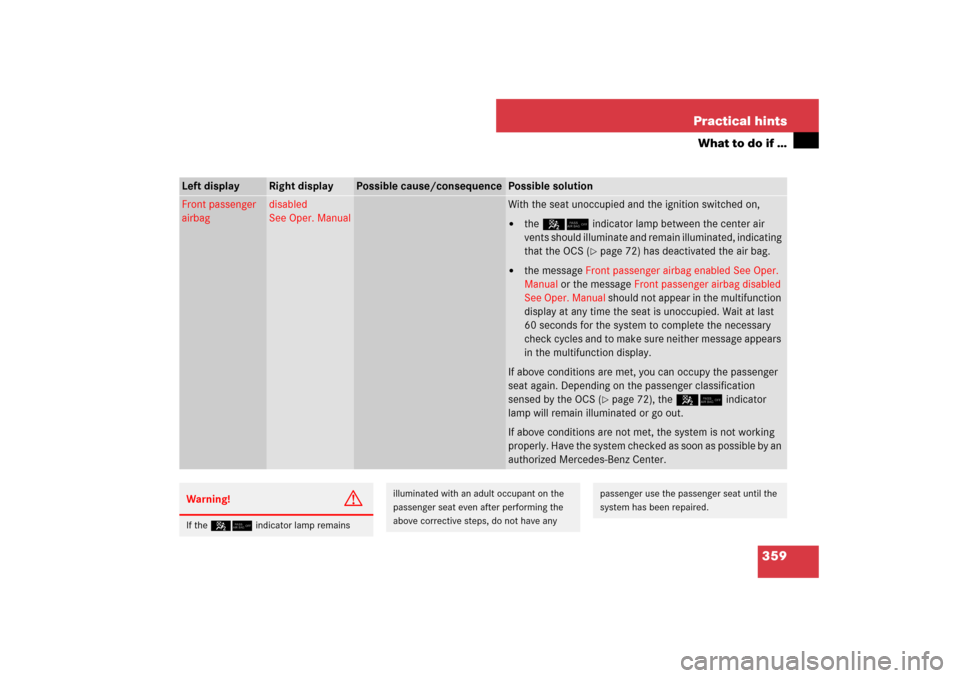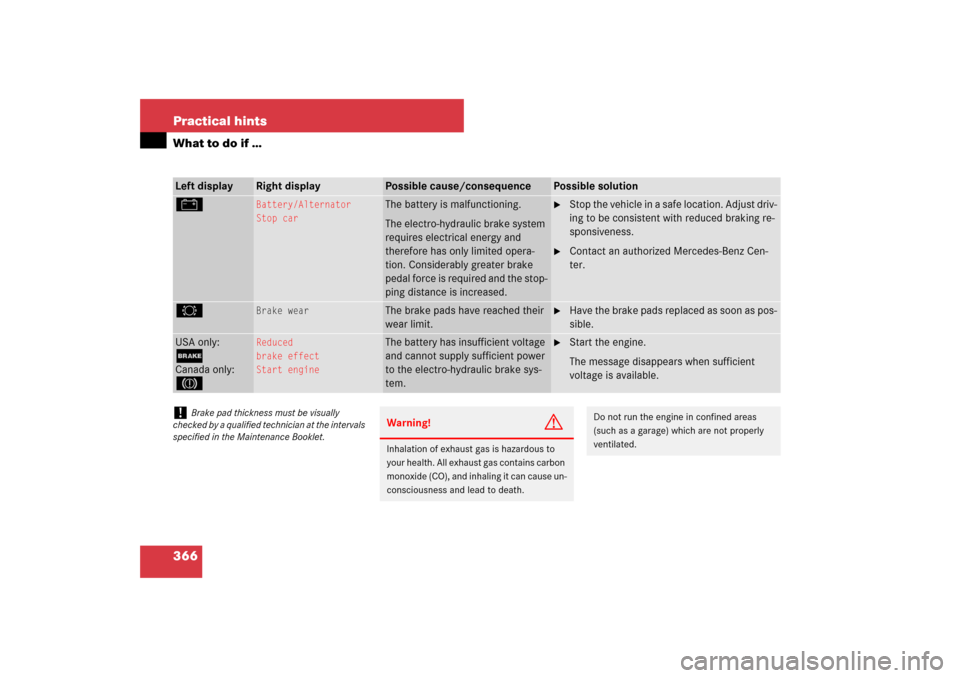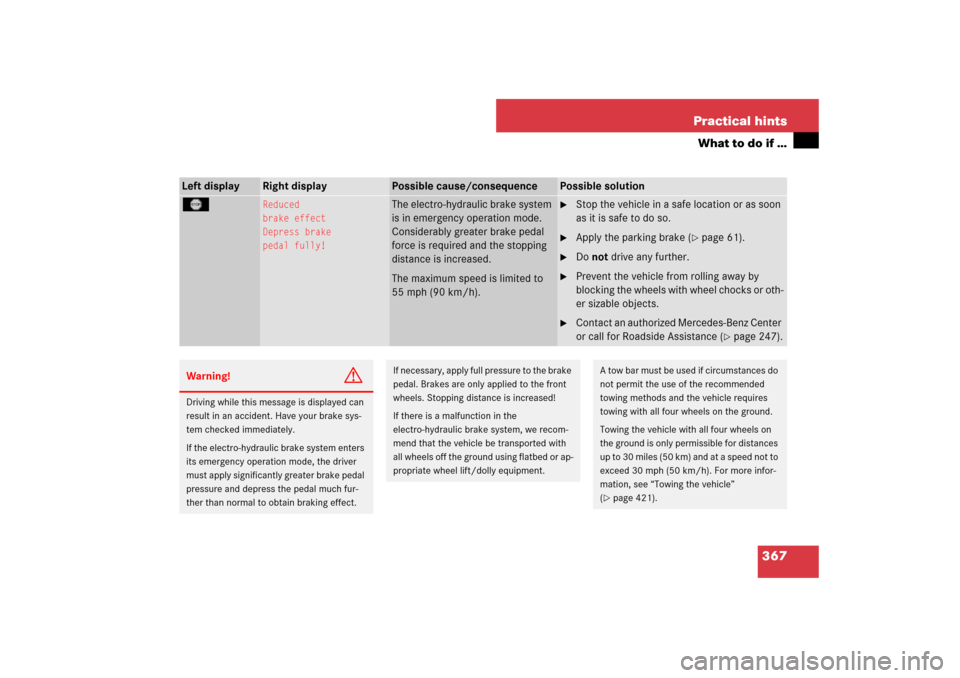Page 360 of 473

359 Practical hints
What to do if …
Left display
Right display
Possible cause/consequence
Possible solution
Front passenger
airbag
disabled
See Oper. Manual
With the seat unoccupied and the ignition switched on,�
the 5/indicator lamp between the center air
vents should illuminate and remain illuminated, indicating
that the OCS (
�page 72) has deactivated the air bag.
�
the message Front passenger airbag enabled See Oper.
Manual or the message Front passenger airbag disabled
See Oper. Manual should not appear in the multifunction
display at any time the seat is unoccupied. Wait at last
60 seconds for the system to complete the necessary
check cycles and to make sure neither message appears
in the multifunction display.
If above conditions are met, you can occupy the passenger
seat again. Depending on the passenger classification
sensed by the OCS (
�page 72), the 5/indicator
lamp will remain illuminated or go out.
If above conditions are not met, the system is not working
properly. Have the system checked as soon as possible by an
authorized Mercedes-Benz Center.
Warning!
G
If the 5/indicator lamp remains
illuminated with an adult occupant on the
passenger seat even after performing the
above corrective steps, do not have any
passenger use the passenger seat until the
system has been repaired.
Page 362 of 473
361 Practical hints
What to do if …
Left display
Right display
Possible cause/consequence
Possible solution
SRS
Restraint system
malfunction
Visit
workshop
There is a malfunction in the supple-
mental restraint systems. The air bags
or emergency tensioning devices
(ETDs) could deploy unexpectedly or
fail to activate in an accident.
�
Drive with added caution and have the
system checked at an authorized
Mercedes-Benz Center immediately.
Warning!
G
In the event a malfunction of the SRS is indi-
cated as outlined above, the SRS may not be
operational. For your safety, we strongly
recommend that you visit an authorized
Mercedes-Benz Center immediately to have
the system checked; otherwise the SRS may
not be activated when needed in an acci-
dent, which could result in serious or fatal
injury, or it might deploy unexpectedly and
unnecessarily which could result in an acci-
dent and/or injury to you or to others.
Page 363 of 473

362 Practical hintsWhat to do if …Left display
Right display
Possible cause/consequence
Possible solution
Check tires
Then restart
Run Flat Indicator
There was a warning message
about a loss in the tire inflation
pressure and the Run Flat Indica-
tor has not been reactivated yet.
�
Make sure that the correct tire inflation
pressure is set for each tire.
�
Then reactivate the Run Flat Indicator.
Run Flat Indicator
inoperative
The Run Flat Indicator is
malfunctioning.
�
Have the Run Flat Indicator checked by an
authorized Mercedes-Benz Center.
The Run Flat Indicator has been
switched off due to an error.
Tire pressure
Check tires
The Run Flat Indicator indicates
that the pressure is too low in one
or more tires.
�
Carefully bring the vehicle to a halt, avoiding
abrupt steering and braking maneuvers. Ob-
serve the traffic situation around you.
�
Check and adjust tire inflation pressure as
required (
�page 292).
�
If necessary, change the wheel
(�page 405).
�
Reactivate the Run Flat Indicator after ad-
justing the tire inflation pressure values
(�page 294).
Page 365 of 473
364 Practical hintsWhat to do if …Left display
Right display
Possible cause/consequence
Possible solution
Tire pressure monitor
currently
unavailable
The TPMS or Advanced TPMS* is
unable to monitor the tire pres-
sure due to�
a nearby radio interference
source.
�
excessive wheel sensor tem-
peratures.
As soon as the causes for the malfunction are
no longer present, the TPMS or Advanced
TPMS* automatically becomes active again
after a few minutes driving.
Warning!
G
Do not drive with a flat tire. A flat tire affects
the ability to steer or brake the vehicle.
You may lose control of the vehicle. Contin-
ued driving with a flat tire will cause exces-
sive heat build-up and possibly a fire.
Page 367 of 473

366 Practical hintsWhat to do if …Left display
Right display
Possible cause/consequence
Possible solution
#
Battery/Alternator
Stop car
The battery is malfunctioning.
The electro-hydraulic brake system
requires electrical energy and
therefore has only limited opera-
tion. Considerably greater brake
pedal force is required and the stop-
ping distance is increased.
�
Stop the vehicle in a safe location. Adjust driv-
ing to be consistent with reduced braking re-
sponsiveness.
�
Contact an authorized Mercedes-Benz Cen-
ter.
2
Brake wear
The brake pads have reached their
wear limit.
�
Have the brake pads replaced as soon as pos-
sible.
USA only:;Canada only:3
Reduced
brake effect
Start engine
The battery has insufficient voltage
and cannot supply sufficient power
to the electro-hydraulic brake sys-
tem.
�
Start the engine.
The message disappears when sufficient
voltage is available.
!
Brake pad thickness must be visually
checked by a qualified technician at the intervals
specified in the Maintenance Booklet.
Warning!
G
Inhalation of exhaust gas is hazardous to
your health. All exhaust gas contains carbon
monoxide (CO), and inhaling it can cause un-
consciousness and lead to death.
Do not run the engine in confined areas
(such as a garage) which are not properly
ventilated.
Page 368 of 473

367 Practical hints
What to do if …
Left display
Right display
Possible cause/consequence
Possible solution
T
Reduced
brake effect
Depress brake
pedal fully!
The electro-hydraulic brake system
is in emergency operation mode.
Considerably greater brake pedal
force is required and the stopping
distance is increased.
The maximum speed is limited to
55 mph (90 km/h).
�
Stop the vehicle in a safe location or as soon
as it is safe to do so.
�
Apply the parking brake (
�page 61).
�
Do not drive any further.
�
Prevent the vehicle from rolling away by
blocking the wheels with wheel chocks or oth-
er sizable objects.
�
Contact an authorized Mercedes-Benz Center
or call for Roadside Assistance (
�page 247).
Warning!
G
Driving while this message is displayed can
result in an accident. Have your brake sys-
tem checked immediately.
If the electro-hydraulic brake system enters
its emergency operation mode, the driver
must apply significantly greater brake pedal
pressure and depress the pedal much fur-
ther than normal to obtain braking effect.
If necessary, apply full pressure to the brake
pedal. Brakes are only applied to the front
wheels. Stopping distance is increased!
If there is a malfunction in the
electro-hydraulic brake system, we recom-
mend that the vehicle be transported with
all wheels off the ground using flatbed or ap-
propriate wheel lift/dolly equipment.
A tow bar must be used if circumstances do
not permit the use of the recommended
towing methods and the vehicle requires
towing with all four wheels on the ground.
Towing the vehicle with all four wheels on
the ground is only permissible for distances
up to 30 miles (50 km) and at a speed not to
exceed 30 mph (50 km/h). For more infor-
mation, see “Towing the vehicle”
(�page 421).
Page 369 of 473

368 Practical hintsWhat to do if …Left display
Right display
Possible cause/consequence
Possible solution
USA only:;Canada only:3
Reduced
brake effect
Visit
workshop
The electro-hydraulic brake system
is in emergency operation mode.
Considerably greater brake pedal
force is required and the stopping
distance is increased.
�
Stop the vehicle in a safe location or as soon
as it is safe to do so.
�
Apply the parking brake (
�page 61).
�
Do not drive any further.
�
Prevent the vehicle from rolling away by
blocking the wheels with wheel chocks or oth-
er sizable objects.
�
Contact an authorized Mercedes-Benz Center
or call for Roadside Assistance (
�page 247).
Warning!
G
Driving while this message is displayed can
result in an accident. Have your brake sys-
tem checked immediately.
If the electro-hydraulic brake system enters
its emergency operation mode, the driver
must apply significantly greater brake pedal
pressure and depress the pedal much fur-
ther than normal to obtain braking effect.
If necessary, apply full pressure to the brake
pedal. Brakes are only applied to the front
wheels. Stopping distance is increased!
If there is a malfunction in the
electro-hydraulic brake system, we recom-
mend that the vehicle be transported with
all wheels off the ground using flatbed or ap-
propriate wheel lift/dolly equipment.
A tow bar must be used if circumstances do
not permit the use of the recommended
towing methods and the vehicle requires
towing with all four wheels on the ground.
Towing the vehicle with all four wheels on
the ground is only permissible for distances
up to 30 miles (50 km) and at a speed not to
exceed 30 mph (50 km/h). For more infor-
mation, see “Towing the vehicle”
(�page 421).
Page 370 of 473
369 Practical hints
What to do if …
Left display
Right display
Possible cause/consequence
Possible solution
USA only:;Canada only:3
Check
brake fluid level
There is insufficient brake fluid in
the reservoir.
Risk of accident!�
Stop the vehicle in a safe location or as soon
as it is safe to do so.
�
Do not drive any further.
�
Contact an authorized Mercedes-Benz
Center.
Do not add brake fluid! This will not solve the
problem.
Warning!
G
Driving with the message
Check brake
fluid level
displayed can result in an ac-
cident. Have your brake system checked im-
mediately. Do not add brake fluid before
checking the brake system. Overfilling the
brake fluid reservoir can result in spilling
brake fluid on hot engine parts and the
brake fluid catching fire. You can be serious-
ly burned.
!
If you find that the brake fluid in the brake
fluid reservoir has fallen to the minimum mark or
below, have the brake system checked for brake
pad thickness and leaks.